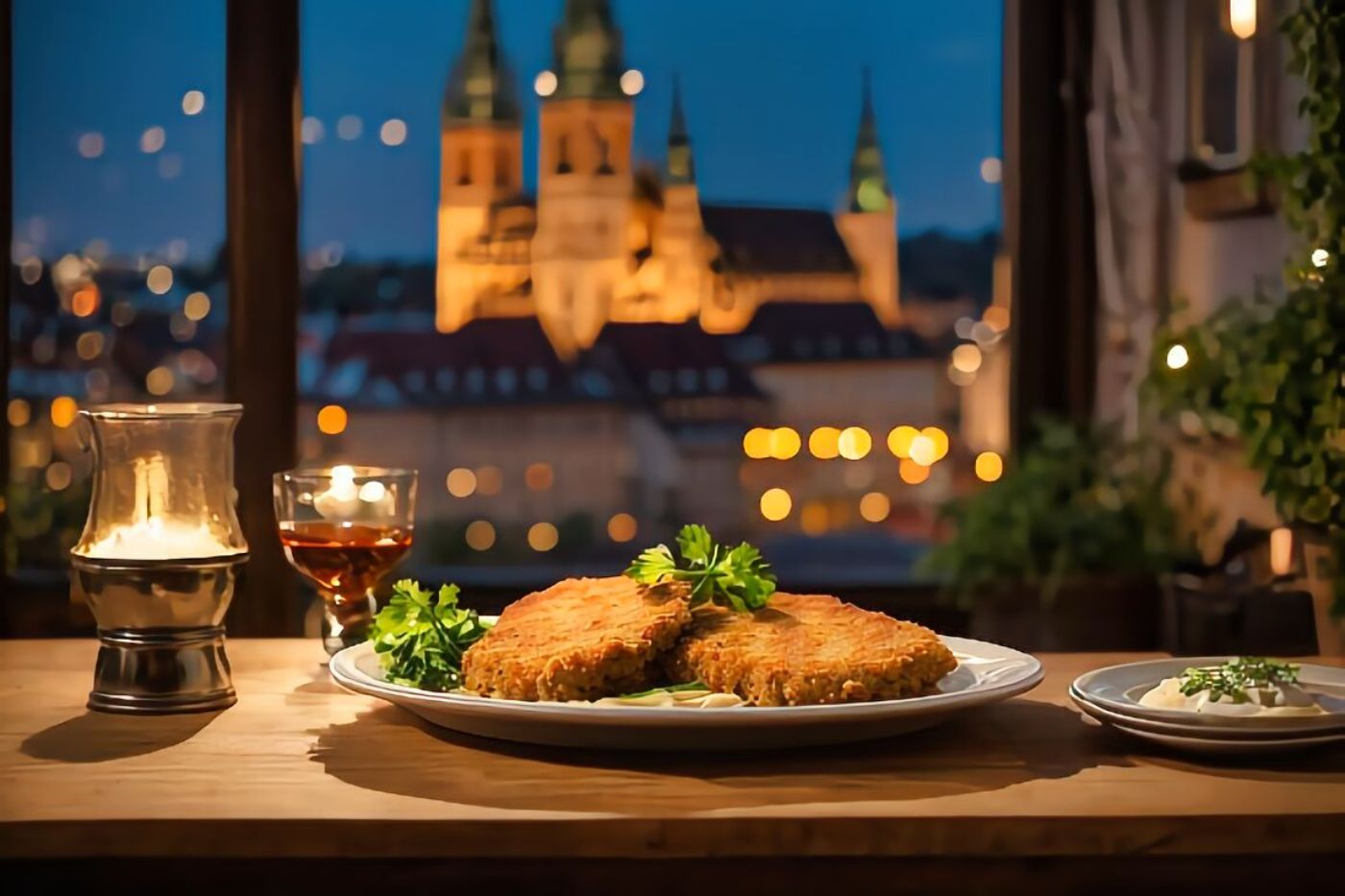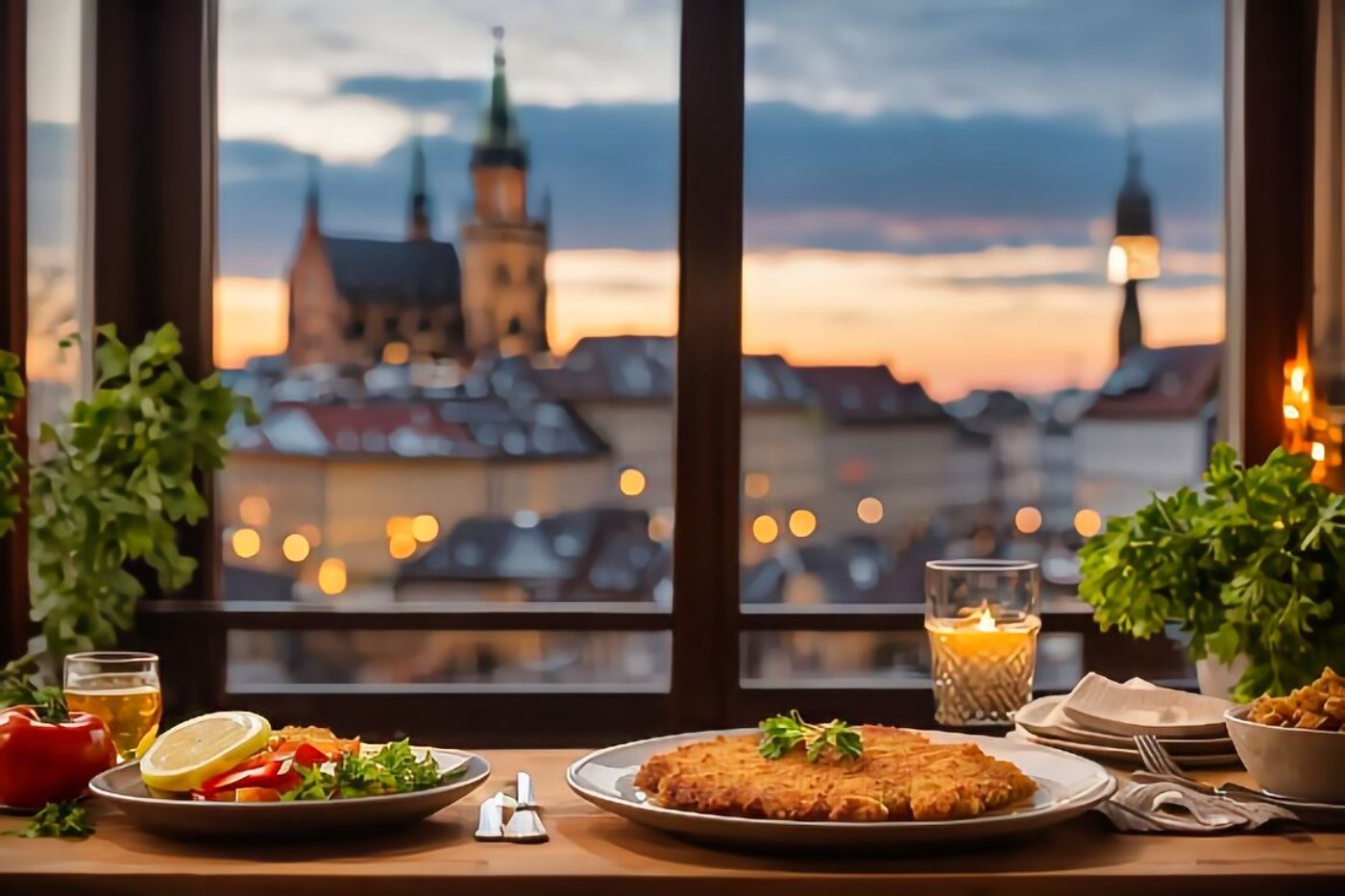
The German Schnitzel Recipe is a traditional dish that features a thin, breaded, and fried piece of meat, typically veal or pork. It’s a beloved classic in German cuisine, known for its simplicity and delicious taste. The key to a good German Schnitzel is achieving a crispy golden-brown crust while keeping the meat tender and juicy on the inside. This dish is often served with lemon wedges, which add a tangy kick to the flavors. The German Schnitzel Recipe has been enjoyed for generations and continues to be a popular choice in German restaurants and homes.
German Food History:
Germany boasts a rich culinary history that has evolved over centuries. The country’s food history reflects its geographic diversity and cultural influences. In ancient times, Germanic tribes relied on agriculture, with grains, vegetables, and meat as dietary staples. With time, trade routes and connections to neighboring countries introduced new ingredients and cooking techniques. The Middle Ages witnessed the emergence of beer and the brewing industry, which is now synonymous with Germany. The Renaissance period brought more refined cooking methods, and the use of spices became prominent.
Want more ideas for Your German Recipe Box?
A lot of great options are in these posts!
24 Traditional German Recipes/a>
You May Want to Join The World Recipes With Our Big Escape
Share your own recipes in our Facebook Group. Find recipes from all over the world. Learn more about International Cuisine and how you can surprise your family with new and exciting foods from all over the world.
For More Photos Visit Our Instagram at World Recipes Daily
Modern Food vs Historic Food:
The transition from historic German food to modern cuisine has seen significant changes. Historic German food was hearty and based on locally available ingredients, often preserving food through methods like salting and pickling. Modern German cuisine, on the other hand, is influenced by international flavors and techniques. The use of spices, herbs, and international ingredients has expanded the palate of modern German dishes. Additionally, there’s a growing emphasis on health-conscious choices, with lighter cooking methods and a focus on fresh, seasonal produce.
German Schnitzel RecipeHealth Benefits:
The German Schnitzel Recipe, when prepared with lean meat and a minimal amount of oil, can offer some health benefits. Lean cuts of pork or veal provide a good source of protein, which is essential for muscle development and overall body function. The dish can also be rich in vitamins and minerals, especially if accompanied by vegetables. However, it’s important to note that the frying process can add calories and fat to the dish. To make it healthier, one can choose to pan-fry Schnitzel with less oil or opt for oven-baked versions. Additionally, the use of whole-grain breadcrumbs can increase the fiber content, promoting better digestion.
In conclusion, the German Schnitzel Recipe is a cherished part of German cuisine, known for its crispy exterior and tender meat. Germany’s food history is a tale of evolution, influenced by cultural exchanges and culinary developments. The shift from historic to modern German food highlights changes in taste preferences and cooking methods. When prepared mindfully, the German Schnitzel Recipe can offer some health benefits, making it a delightful choice for those looking to enjoy a traditional German dish.

How To Make Our German Schnitzel Recipe
Ingredients (8 Servings)
8 boneless pork steaks or chops, (to make Austrian Wienerschnitzel use thin veal cutlets)
salt and freshly ground black pepper
1 cup all-purpose flour combined with 1 teaspoon salt
4 large eggs, lightly beaten
1 1/2 cup plain breadcrumbs
Oil for frying (use a neutral-tasting oil with a high smoke point)
Instructions
1. Begin by preparing the meat.
a. Lay out the boneless pork steaks or chops on a clean, dry surface.
b. Season each piece with salt and freshly ground black pepper to taste.
2. Set up your breading station.
a. In a shallow dish, combine 1 cup of all-purpose flour with 1 teaspoon of salt.
b. In another shallow dish, place the lightly beaten eggs.
c. In a third shallow dish, spread out 1 1/2 cups of plain breadcrumbs.
3. Bread the pork.
a. Take a seasoned pork steak or chop and coat it thoroughly in the flour mixture, pressing the flour onto the meat.
b. Next, dip the floured meat into the beaten eggs, ensuring an even coating.
c. Finally, place the meat in the breadcrumbs, pressing the breadcrumbs onto the meat to create a solid crust. Repeat this process for each piece of pork.
4. Heat the frying oil.
a. In a large skillet or frying pan, add enough neutral-tasting oil to cover the bottom generously.
b. Heat the oil over medium-high heat until it reaches a temperature of around 350-375°F (175-190°C). You can test the readiness by dropping a breadcrumb into the oil; it should sizzle and brown.
5. Fry the schnitzel.
a. Carefully place the breaded pork into the hot oil. You may need to do this in batches to avoid overcrowding the pan.
b. Cook each piece for about 3-4 minutes on each side, or until they are golden brown and crispy.
c. As you cook, place the schnitzel on a plate lined with paper towels to drain any excess oil.
6. Serve the German Schnitzel.
a. Transfer the fried schnitzel to a serving platter.
b. Optionally, you can garnish it with lemon wedges before serving.
Estimated Prep Time: 15 minutes
Estimated Cooking Time: 20-30 minutes (depending on batch size and pan size)

Pots, Pans and Cooking Equipment Needed for The Apfelstrudel German Schnitzel Recipe
Large skillet or frying pan for frying the schnitzel
Shallow dishes or plates for breading the meat (3 in total)
Tongs or a fork for handling the meat
Paper towels for draining excess oil
Best Way to Store Leftovers From The German Schnitzel Recipe
a. Store any leftover German Schnitzel in an airtight container in the refrigerator.
b. To maintain its crispiness, place a paper towel between the schnitzel slices.
c. Consume leftover schnitzel within 2-3 days for the best taste and texture.
d. Avoid freezing as the breading may become soggy when thawed.
e. Reheat in an oven or toaster oven to maintain its crunchiness.
f. Do not microwave, as it can make the schnitzel lose its crispy coating.
Tips and Tricks For Easier Creation
Pound the meat to an even thickness for uniform cooking.
Use fresh breadcrumbs for a better crust.
Preheat the oil to the correct temperature to ensure a crispy finish.
Press the breadcrumbs onto the meat firmly to create a secure coating.
Fry in batches to avoid overcrowding the pan.
Keep an eye on the oil temperature to prevent burning.
Use a meat thermometer to ensure the pork is cooked to a safe internal temperature.
Side Dishes and Desserts For the German Schnitzel Recipe
a. Potato salad
b. Cucumber salad
c. Red cabbage slaw
d. Sauerkraut
e. Mashed potatoes
f. Steamed vegetables
g. Spaetzle (German egg noodles)
How To Serve the German Schnitzel Recipe
a. Place the schnitzel on a serving platter.
b. Garnish with lemon wedges if desired.
c. Serve hot and enjoy with your chosen side dishes.
d. Consider a drizzle of fresh lemon juice for added flavor.
e. Offer mustard or a creamy sauce as condiments for dipping.
f. Accompany with a glass of German beer or white wine for an authentic experience.
Dietary Substitution For German Schnitzel Recipe
1. Vegan Options for the German Schnitzel Recipe:
a. Substitute boneless pork steaks with thin slices of eggplant.
b. Replace eggs with a vegan egg replacer or a mixture of water and ground flaxseed.
c. Use almond or soy milk in place of eggs for dipping.
d. Replace breadcrumbs with crushed, seasoned cornflakes for a vegan-friendly breading.
e. Opt for vegetable oil or coconut oil for frying instead of animal-based oil.
2. Gluten-Free Options for the German Schnitzel Recipe:
a. Replace all-purpose flour with gluten-free all-purpose flour.
b. Use gluten-free breadcrumbs or crushed gluten-free cornflakes for breading.
c. Ensure the seasoning used is gluten-free.
d. Confirm that the eggs used are gluten-free.
e. Check the oil used for frying to ensure it’s gluten-free.
3. Vegetarian Options for the German Schnitzel Recipe:
a. Substitute boneless pork steaks with thin slices of halloumi cheese.
b. Use vegetarian-friendly breadcrumbs for breading.
c. Ensure the seasoning used is vegetarian.
d. Confirm that the eggs used are from vegetarian sources.
e. Opt for vegetable oil or coconut oil for frying.
4. Mediterranean Diet Options for the German Schnitzel Recipe:
a. Use extra virgin olive oil for frying instead of neutral oil.
b. Serve the schnitzel with a side of Greek salad with fresh tomatoes, cucumbers, and feta cheese.
c. Garnish with lemon wedges and fresh herbs for added Mediterranean flavor.
d. Accompany with a tzatziki sauce made from yogurt, cucumber, and garlic.
e. Consider adding olives and capers to the breading mixture for a Mediterranean twist.
5. Keto Diet Options for the German Schnitzel Recipe:
a. Replace all-purpose flour with almond flour or coconut flour for breading.
b. Use crushed pork rinds instead of breadcrumbs for a low-carb option.
c. Ensure the seasoning used is keto-friendly.
d. Confirm that the eggs used are suitable for a keto diet.
e. Use an oil with a high smoke point like avocado oil for frying.
6. Heart-Healthy Diet Options for the German Schnitzel Recipe:
a. Choose lean cuts of pork or veal to reduce saturated fat.
b. Use whole wheat breadcrumbs for added fiber.
c. Opt for olive oil or canola oil for frying instead of oils high in saturated fat.
d. Serve with a side of steamed vegetables or a fresh salad for added nutrients.
e. Use less salt in the breading mixture and season with herbs and spices instead.
7. Paleo Options for the German Schnitzel Recipe:
a. Substitute all-purpose flour with almond flour for breading.
b. Use crushed pork rinds or almond meal instead of breadcrumbs.
c. Ensure the seasoning used is paleo-friendly.
d. Confirm that the eggs used are paleo-approved.
e. Fry in coconut oil or avocado oil for a paleo-friendly choice.
8. Low Carb Options for the German Schnitzel Recipe:
a. Replace all-purpose flour with almond flour or coconut flour for breading.
b. Use crushed pork rinds or almond meal instead of breadcrumbs.
c. Ensure the seasoning used is low in carbs.
d. Confirm that the eggs used are suitable for a low-carb diet.
e. Use an oil with a high smoke point like avocado oil for frying.
9. Whole 30 Options for the German Schnitzel Recipe:
a. Choose high-quality pork or veal, preferably without additives or preservatives.
b. Use almond flour or coconut flour for breading.
c. Ensure the seasoning used is Whole 30 compliant.
d. Confirm that the eggs used are from pastured chickens.
e. Fry in avocado oil or olive oil for a Whole 30-friendly option.
10. Weight Watchers Options for the German Schnitzel Recipe:
a. Use lean cuts of pork or veal to reduce SmartPoints values.
b. Opt for whole wheat breadcrumbs for added fiber.
c. Ensure the seasoning used is low in added sugars and fats.
d. Confirm that the eggs used are part of the Weight Watchers plan.
e. Use a minimal amount of oil for frying to control SmartPoints.
11. Low-Fat Options for the German Schnitzel Recipe:
a. Choose lean cuts of pork or veal with minimal visible fat.
b. Use a minimal amount of oil for frying or consider using an oil spray.
c. Opt for whole wheat breadcrumbs for added fiber.
d. Ensure the seasoning used is low in added fats.
e. Confirm that the eggs used are low in fat.
12. Vegetable Variations for the German Schnitzel Recipe:
a. Substitute boneless pork steaks with thick slices of portobello mushrooms.
b. Use a vegan egg replacer or almond milk for dipping.
c. Bread the mushrooms with seasoned almond flour or gluten-free breadcrumbs.
d. Opt for vegetable oil or coconut oil for frying.
e. Season the mushroom schnitzel with a variety of herbs and spices for flavor.
It’s always recommended to check labels, choose quality ingredients, and consult with a healthcare professional or registered dietitian for personalized advice. Please note that these substitutions are provided as options to align the recipe with various dietary preferences and restrictions. Always check labels and choose ingredients that fit your specific dietary needs. Consult with a healthcare professional or registered dietitian for personalized advice.

FAQ About German Schnitzel Recipe
What is the German Schnitzel Recipe?
The German Schnitzel Recipe is a traditional dish made from thin slices of meat, typically pork or veal, coated in breadcrumbs and fried to a crispy golden-brown.
What is the key to achieving a perfect German Schnitzel?
The key to a perfect German Schnitzel is to ensure the meat is thin and evenly pounded, the breading is well-seasoned, and it is fried to a crisp in hot oil.
What are common accompaniments to the German Schnitzel Recipe?
Common accompaniments to the German Schnitzel Recipe include lemon wedges for garnish, potato salad, cucumber salad, red cabbage slaw, and various dipping sauces.
Can the German Schnitzel Recipe be adapted for different dietary preferences?
Yes, the German Schnitzel Recipe can be adapted for different dietary preferences, including vegan, vegetarian, gluten-free, and low-carb options by using suitable substitutions.
What is the origin of the German Schnitzel Recipe?
The German Schnitzel Recipe has its origins in traditional German cuisine and is believed to have evolved over centuries as a popular dish in Germany.
Final Thoughts
“We are a couple who has visited and sampled food in every country in the world. We strive to get a local recipe for every dish we place on our blog. Some we have cooked in our kitchen but most we enjoyed in the restaurants and streets of the world. Our thoughts and opinions are based on the food we loved the most, and you may find them and others you will fall in love with as well. Please enjoy the recipe and comment below.”
The German Schnitzel Recipe is a beloved classic in German cuisine. It consists of thin slices of meat, usually pork or veal, coated in breadcrumbs and fried until crispy and golden brown. This iconic dish is known for its simplicity and delicious taste, making it a favorite not only in Germany but also around the world.
The key to a perfect German Schnitzel lies in the preparation. The meat is pounded until it’s thin and even, ensuring that it cooks quickly and uniformly. Then, it’s seasoned with salt and freshly ground black pepper, enhancing the flavors of the meat. The next step involves coating the meat in a mixture of all-purpose flour and a touch of salt, providing the initial layer for the crispy breading.
After the flour coating, the meat is dipped into beaten eggs, which act as a binding agent. The eggs create a bond between the meat and the final layer of plain breadcrumbs, forming the iconic crispy crust that makes the German Schnitzel so delightful. These breadcrumbs are generously applied, ensuring an even and crunchy coating.
To achieve that perfect golden brown color and crispy texture, the schnitzel is fried in hot oil. A neutral-tasting oil with a high smoke point is used to prevent any unwanted flavors from affecting the dish. The schnitzel is carefully placed in the hot oil and fried for about 3-4 minutes on each side until it’s beautifully golden and crispy.
Traditionally, the German Schnitzel is served with lemon wedges, which add a delightful tangy kick to the flavors. The contrast of the tender meat and the crispy crust, along with the zesty lemon, creates a harmonious and satisfying culinary experience.
Whether enjoyed in a cozy German restaurant or prepared in your own kitchen, the German Schnitzel Recipe is a true crowd-pleaser. Its timeless appeal and straightforward preparation have made it a staple in German cuisine, and it’s a dish that continues to bring joy to food enthusiasts worldwide.
German Schnitzel Recipe
Ingredients
Equipment
Method
- a. Lay out the boneless pork steaks or chops on a clean, dry surface.
- b. Season each piece with salt and freshly ground black pepper to taste.
- a. In a shallow dish, combine 1 cup of all-purpose flour with 1 teaspoon of salt.
- b. In another shallow dish, place the lightly beaten eggs.
- c. In a third shallow dish, spread out 1 1/2 cups of plain breadcrumbs.
- a. Take a seasoned pork steak or chop and coat it thoroughly in the flour mixture, pressing the flour onto the meat.
- b. Next, dip the floured meat into the beaten eggs, ensuring an even coating.
- c. Finally, place the meat in the breadcrumbs, pressing the breadcrumbs onto the meat to create a solid crust. Repeat this process for each piece of pork.
- a. In a large skillet or frying pan, add enough neutral-tasting oil to cover the bottom generously.
- b. Heat the oil over medium-high heat until it reaches a temperature of around 350-375°F (175-190°C). You can test the readiness by dropping a breadcrumb into the oil; it should sizzle and brown.
- a. Carefully place the breaded pork into the hot oil. You may need to do this in batches to avoid overcrowding the pan.
- b. Cook each piece for about 3-4 minutes on each side, or until they are golden brown and crispy.
- c. As you cook, place the schnitzel on a plate lined with paper towels to drain any excess oil.


